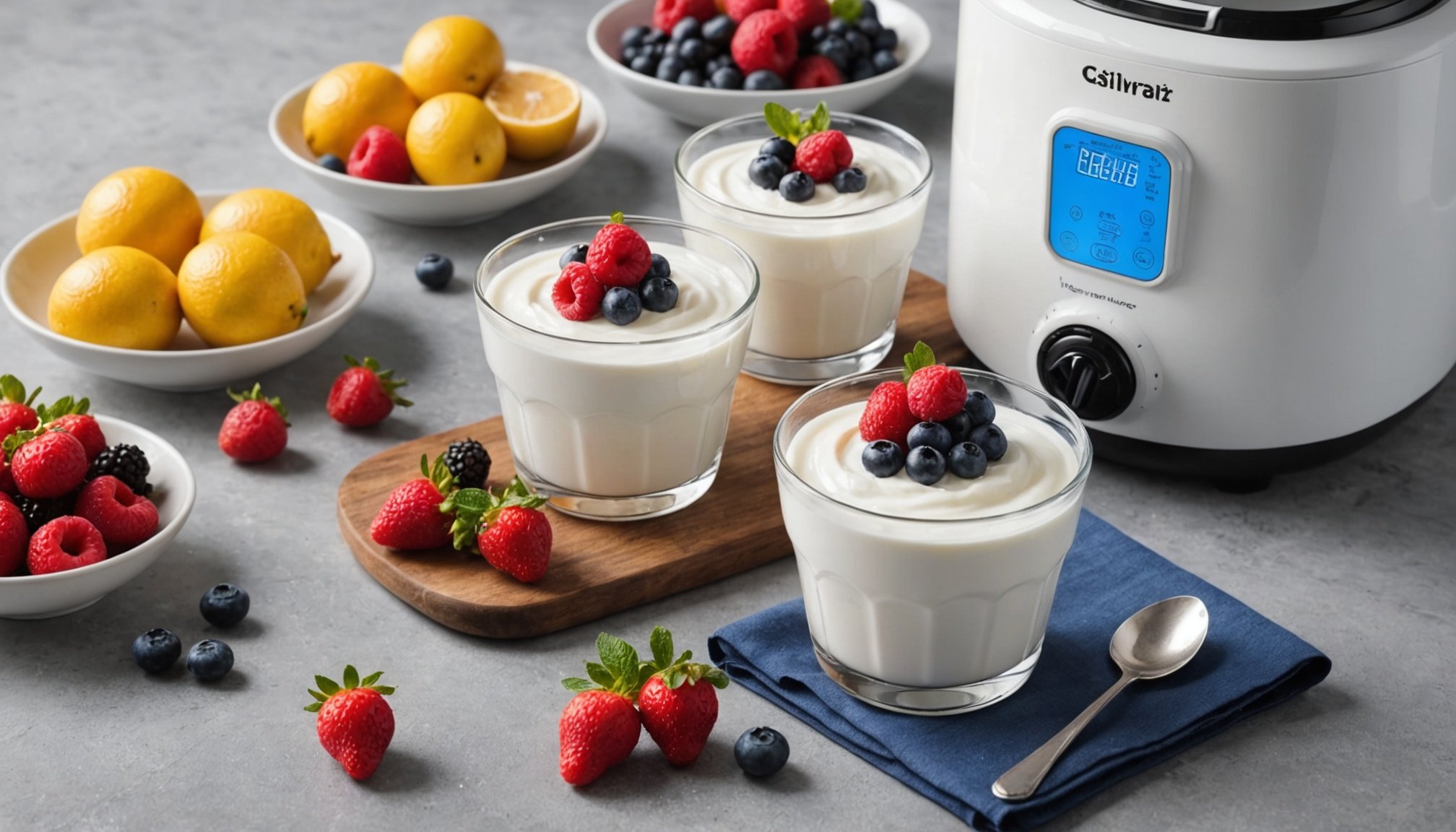Crafting homemade yogurt is not only rewarding but also healthier than store-bought options. Understanding key features of a yogurt maker can enhance your yogurt-making experience. Consider temperature control, capacity, and ease of use as essential factors. These elements significantly impact the texture and flavor of your final product. Whether you’re a novice or a seasoned yogurt enthusiast, investing in the right yogurt maker can transform your kitchen adventures, allowing you to savor delicious, homemade yogurt tailored to your taste.
Essential Features of Yogurt Makers
Exploring the essentials can help you make informed decisions.
This might interest you : Discover the Ultimate Material for Your Non-Slip Kitchen Mat: A Comprehensive Guide
Temperature Control
Temperature control is a critical feature in a yogurt maker. It ensures the ideal conditions for fermentation, which typically occur between 110°F and 115°F. This precision affects the texture and taste of the yogurt. A well-regulated temperature can prevent curdling and ensure a creamy consistency.
Capacity and Serving Size
When considering a yogurt maker, understanding its capacity is vital. Some models can produce a single serving, while others can make up to 2 quarts or more in one batch. This feature allows you to plan based on your family's needs or personal consumption. Larger capacity units are ideal for those who consume yogurt regularly or have a larger household.
Topic to read : Discover the Ultimate Material for Your Non-Slip Kitchen Mat: A Comprehensive Guide
Timer Settings
The timer settings in a yogurt maker play a significant role in the fermentation process. An adjustable timer lets you control the duration of fermentation, which can vary based on the type of milk used or desired tartness.
- Temperature control: Ensures ideal fermentation
- Capacity: Determines batch size
- Timer settings: Controls fermentation duration
Understanding these features can enhance your yogurt-making experience, providing delicious and consistent results every time.
Comparing Different Yogurt Maker Models
Exploring various models can guide you to the best choice.
Key Specifications to Consider
When comparing yogurt maker models, focus on key specifications that match your needs. Look for models with adjustable temperature control and timer settings. These features ensure precise fermentation, affecting the yogurt's texture and taste. Additionally, consider the capacity—whether you need a compact model for single servings or a larger one for family-sized batches.
Price Range Overview
The price range of yogurt makers varies significantly. Entry-level models may start at around $20, offering basic functions. In contrast, premium models with advanced features can exceed $100. Consider your budget and how often you plan to use the device. Investing in a higher-end model might be worthwhile for frequent users, ensuring durability and additional features.
User Ratings and Recommendations
User feedback is invaluable when choosing the best yogurt makers. Highly-rated models often receive praise for ease of use, consistent results, and durability. Look for recommendations highlighting specific features, such as intuitive controls or efficient timer settings.
- Temperature control: Precision is crucial
- Capacity: Choose based on usage
- Price: Align with budget and needs
These insights can assist in selecting a model that meets your requirements.
Tips for Using Yogurt Maker Features Effectively
Enhance your homemade yogurt experience with these expert tips.
Best Practices for Setting Temperature and Time
Achieving the perfect homemade yogurt requires careful attention to temperature and time settings. For most yogurt types, maintaining a constant temperature between 110°F and 115°F is ideal. This range supports optimal fermentation, ensuring a creamy texture. Set the timer based on the desired tartness; longer fermentation results in tangier yogurt. Experimenting with these settings can help you discover your preferred taste and consistency.
How to Use the Capacity for Various Yogurt Types
Understanding your yogurt maker's capacity is key to producing different yogurt types. For Greek yogurt, use the full capacity to allow for straining and thickening. For flavored or fruit-infused varieties, reserve some space to mix in ingredients post-fermentation. Adjusting the batch size can cater to your consumption needs, whether you're making single servings or family-sized portions.
Cleaning and Maintenance Tips for Longevity
Regular cleaning and maintenance ensure your yogurt maker's longevity. After each use, wash all removable parts with warm, soapy water. Avoid abrasive cleaners that may damage surfaces. Periodically check electrical components for wear. A well-maintained yogurt maker not only lasts longer but also consistently produces high-quality yogurt.
- Temperature: 110°F-115°F for optimal fermentation
- Time: Adjust for desired tartness
- Capacity: Tailor batch size to yogurt type
Common Mistakes When Using Yogurt Makers
Avoid these pitfalls for better results.
Overlooking Temperature Stability
Maintaining temperature stability is crucial in yogurt making. Fluctuations can disrupt fermentation, leading to inconsistent texture. Ensure your yogurt maker has a reliable temperature control feature. If the device's environment is too cold or hot, it can affect the yogurt's quality. Always monitor the surrounding conditions to keep the process stable.
Miscalculating Ingredient Ratios
Accurate ingredient ratios are essential for successful yogurt making. Too much or too little starter culture can alter the yogurt's consistency and taste. Follow the manufacturer’s guidelines for the correct proportions. Measuring ingredients precisely ensures the best results and avoids common yogurt maker problems.
Ignoring Cleaning Protocols
Proper cleaning is vital for the longevity of your yogurt maker and the quality of your yogurt. Ignoring cleaning protocols can lead to bacterial growth, affecting the yogurt's flavor and safety. After each use, dismantle the device and clean all parts thoroughly. Regular maintenance prevents yogurt maker problems and ensures consistent results.
- Temperature stability: Crucial for fermentation
- Ingredient ratios: Follow guidelines
- Cleaning protocols: Maintain hygiene
By addressing these common mistakes, you can enhance your yogurt-making experience and ensure delicious outcomes.
User Reviews and Experiences
Exploring real-life insights from yogurt maker users.
Positive User Experiences
Yogurt maker reviews often highlight the ease of use and satisfaction with homemade results. Many users appreciate the ability to customize their yogurt's flavor and texture. A common sentiment is the joy of creating healthier, preservative-free yogurt at home. As one user noted, "The control over ingredients and the freshness of homemade yogurt is unmatched." Customers frequently commend models with intuitive controls and reliable temperature settings for delivering consistent results.
Common Complaints
Despite numerous positive yogurt maker reviews, some users express frustration with specific aspects. A frequent complaint involves capacity limitations, particularly in smaller models. Others mention issues with inconsistent temperature control, leading to unsatisfactory yogurt texture. Some users find the cleaning process cumbersome, especially if the design includes hard-to-reach areas. These insights underscore the importance of choosing a model that aligns with personal needs and preferences.
Case Studies of Successful Yogurt Making
Several case studies from customer feedback reveal successful yogurt-making experiences. Users who follow manufacturer guidelines report achieving desired results consistently. For instance, those who accurately measure ingredients and monitor temperature settings often produce perfect yogurt. These experiences highlight the potential for success when users understand and utilize their yogurt maker's features effectively.
- Temperature settings: Critical for consistency
- Capacity: Consider needs
- Customer feedback: Valuable insights
Advanced Techniques for Crafting Yogurt
Unlock new possibilities with these advanced yogurt-making methods.
Incorporating Flavors and Mix-Ins
Elevate your yogurt recipes by incorporating unique flavors and mix-ins. Start with fresh fruits, nuts, or even spices like cinnamon for an exotic twist. Adding these elements post-fermentation preserves their freshness and enhances the yogurt's taste. Consider layering flavors or creating a fruit compote to swirl through your yogurt for a delightful texture and taste experience.
Experimenting with Different Milk Types
Exploring various milk types can significantly impact your yogurt recipes. Try using almond, coconut, or goat milk to craft unique flavors and consistencies. Each type brings different yogurt making characteristics, such as creaminess or tanginess. Adjust fermentation times accordingly, as non-dairy milks might require longer fermentation for optimal results.
Techniques for Thicker Yogurt Consistency
Achieving a thicker yogurt consistency can enhance the richness of your yogurt recipes. One method is to strain the yogurt post-fermentation, removing excess whey. Alternatively, incorporate thickeners like gelatin or agar-agar during the yogurt making process. Experimentation with these techniques allows you to tailor the texture to your preference, creating a luxurious, creamy product.
- Mix-ins: Add post-fermentation
- Milk types: Explore non-dairy options
- Thicker consistency: Strain or use thickeners
These advanced techniques offer endless possibilities for crafting personalized and delicious yogurt.
Visual Aids for Understanding Yogurt Makers
Visual aids can simplify the yogurt-making process.
Diagrams of Key Features
Understanding the yogurt maker can be greatly enhanced through visual aids. Diagrams often highlight essential components such as the temperature control knob, capacity indicators, and timer settings. These illustrations help users quickly identify each part and understand its function, facilitating a smoother setup and operation process.
Comparison Charts of Popular Models
A comparison chart can be an invaluable tool when evaluating different yogurt maker models. Such charts typically display key features like capacity, temperature control, and price range side-by-side. This format allows users to easily compare and contrast models, aiding in informed decision-making.
| Model | Capacity | Temperature Control | Price |
|---|---|---|---|
| Model A | 1 quart | Adjustable | $30 |
| Model B | 2 quarts | Fixed | $50 |
| Model C | 3 quarts | Adjustable | $70 |
Step-by-Step Infographics for Use
Step-by-step infographics can demystify the yogurt maker usage process. These visual aids often break down the yogurt-making steps, from setting the temperature to adjusting the timer. By following these guides, users can achieve consistent results, enhancing their overall experience.
Cost-Benefit Analysis of Yogurt Makers
Evaluating the financial and health impacts of yogurt makers.
Initial Investment versus Long-Term Savings
Investing in a yogurt maker involves upfront costs, but it can lead to significant long-term savings. While the initial expense might seem high, consider the ongoing cost of store-bought yogurt. Over time, making yogurt at home can be more economical, especially for frequent consumers.
Comparing Store-Bought Yogurt Costs
Store-bought yogurt often comes with a higher price tag due to packaging and marketing costs. By using a yogurt maker, you reduce these expenses. Here's a simple comparison:
| Purchase Type | Average Cost per Serving |
|---|---|
| Store-Bought Yogurt | $1.50 |
| Homemade Yogurt | $0.50 |
This table illustrates the potential savings per serving when using a yogurt maker.
Evaluating the Health Benefits of Homemade Yogurt
Beyond financial savings, homemade yogurt offers health benefits. It allows control over ingredients, avoiding preservatives and excess sugar. As one user remarked, "Making yogurt at home ensures freshness and healthier options." This control enhances the value of owning a yogurt maker, contributing to better dietary choices and overall well-being.
Where to Buy and What to Look For
Choosing the right place to purchase can enhance your buying experience.
Recommended Retailers
When considering where to buy yogurt makers, it's essential to choose reputable retailers. Stores like Best Buy, Target, and Walmart offer a variety of models with competitive pricing. These retailers often provide customer reviews and detailed product descriptions, helping you make an informed decision. Additionally, they frequently have sales, allowing you to find a yogurt maker that fits your budget.
Online vs. In-Store Purchases
Purchasing a yogurt maker online or in-store each has its benefits. Online platforms like Amazon provide convenience and a broader selection, often accompanied by user ratings. In-store shopping, on the other hand, allows you to physically inspect the product and inquire with knowledgeable staff. Consider your preference for tactile experience versus the convenience of home delivery when deciding where to buy yogurt makers.
Key Features to Look For in Retail Listings
When browsing retail listings, focus on key features such as temperature control, capacity, and timer settings. These elements are crucial in ensuring a satisfying yogurt-making experience. Look for models with easy-to-use interfaces and positive user feedback. A well-chosen yogurt maker can enhance your homemade yogurt's quality and consistency.
- Temperature control
- Capacity
- Timer settings













